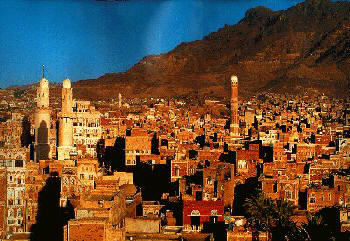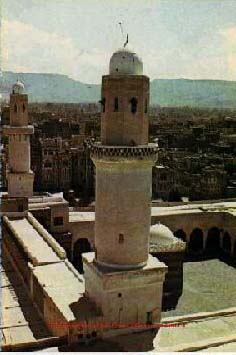


According to popular legend
Sana'a was founded by Shem, son of Noah.
The story tells of how Shem after coming a long way from the north, finally
reached Yemen and found the plain of Sana'a most suitable for settlement. Shem
chose originally the western part of the Sana'a plain close to Mount Aiban. When
he began to lay the foundations a bird came and picked up his sounding lead.
Shem followed the bird convinced that it was sent by Allah to show him a more
suitable place. The bird flew to the eastern part of the Sana'a plain and
dropped the lead at the foot of Mount Nugum. Shem then laid the foundations for
a city that was called "Madinat Sam" (the city of Shem). Later, the name changed
to Azal (from the biblical Uzal -Gen. 10:27 - the sixth son of Joktan, the
Arabic Qahtan). Finally, it was called Sana'a, meaning "the fortified one", in
ancient inscription.
The first inscriptions referring to Sana'a as a city date back to the first
century AD. Yet Sana'a, as a citadel along the trade route between Aden and
Mecca, watching over a large seasonal market, is certainly older than that.
Mohammed Al-Hamdani, the 10th century historian, mentions the Sabean King Sha'r
Awtar as the builder of the city wall around Sana'a along with the famous
Ghumdan Palace. King Sha'r Awtar lived during the second half of the 2nd century
AD. The lack of any inscriptions of Sana'a between the third and he early sixth
century only confirms the fact that Dhofar (near Yarim) was the capital of he
Himyarite kingdom. Even Mareb, the ancient capital of the Sabeans had become
secondary by this time. However, it is believed that the last Himyarite kings
had ruled Yemen from Sana'a, namely from the palace of Ghumdan. When the
Ethiopians conquered Yemen in 525 AD and 50 years later the Persians, Dhofar had
already lost its position as capital in favor of Sana'a.

During the century before the arrival of
Islam, Sana'a had two outstanding buildings the Ghumdan Palace, possibly
constructed by King Sha'r Awtar and the Sana'a Cathedral, called al-Galis (from
the Latin ecclesia), built by Abraha, the Ethiopian ruler, in the early years of
his reign. Yemeni historians report on the Ghumdan Palace as consisting of
twenty floors. Each of the four sides was built with differently colored stones.
Four bronze lions at each corner would roar with the blowing wind. The roof was
made of translucent alabaster so clear that the king could see the birds flying
over. The same historians report on the Galis Cathedral: the entire ceiling was
made from teak held together by gold and silver nails, the pulpit was of pure
ebony plated with gold and silver. So splendid was the cathedral that people
from Yemen and other parts of Arabia would make pilgrimages to it.
When Islam arrived in Yemen (in 628 AD), both buildings, the Ghumdan Palace and the Galis Cathedral were destroyed. From the ruins and rubbles two new constructions were erected: the Great Mosque of Sana'a and a new castle on the ruins of a Himyarite citadel close to Mount Nugum that has always been the highest point of Sana'a. AlHamdani could still see the ruins of the Ghumdan Palace during his life time, before they disappeared completely. Of the Galis Cathedral, only the round foundation walls of the baptistery have remained till the present day (Byzantine sources report on a bishopry in Sana'a until the ninth century AD).
 The
Great Mosque, the new castle (Qasar al-Silah) and the expanded and permanent
market became the new characteristics of Islamic Sana'a. All three have remained
intact and kept their original function until our present 20th century.
The
Great Mosque, the new castle (Qasar al-Silah) and the expanded and permanent
market became the new characteristics of Islamic Sana'a. All three have remained
intact and kept their original function until our present 20th century.
During the following centuries, Sana'a became the focal point of power struggles
between little kingdoms and the target for foreign invasions. Sana'a remained
the capital of Yemen and to conquer it was to conquer Yemen at least
symbolically. Hardly any other Yemeni city has seen so much blood shed and
suffered so many conquests. Yahia bin Hussein, a Yemeni historian, writes on
11th century Sana'a: "Ruin prevailed in Sana'a and elsewhere in Yemen because of
disputes, rivalries and disunity. Sana'a and its suburbs became as if they had
burned down. Every year, even every month, some new Sultan seized power"
Sana'a
was conquered by the Egyptian Mamlukes in the 16th century, soon to be followed
by the Ottoman Turks in 1538 AD. The Ottoman Turks were expelled by the Zaydi
Imams, but returned to Sana'a in 1872 AD until the end of World War 1. The
capital was sacked by Imam Ahmed's forces in 1948 AD and suffered heavy damage
during the Civil War, when royalist forces bombed Sana'a without interruption
for 70 days (the 70 days siege at the end of 1967).
Yet, in between these times of war, there have been periods of peace and
prosperity. Early European visitors write all very favorably about the fruit
gardens in and around Sana'a, especially in Bir al-Azab, the garden city west of
the old center. It is now difficult to imagine that Sana’a was once lying in the
middle of a green plain with intensive agriculture beginning just beyond its
city walls.


